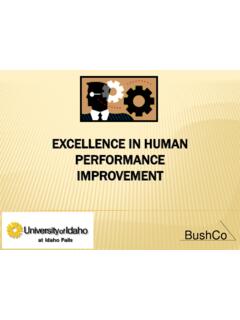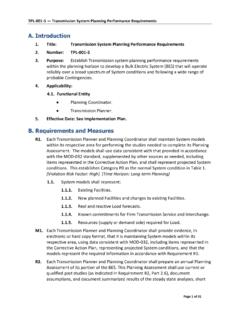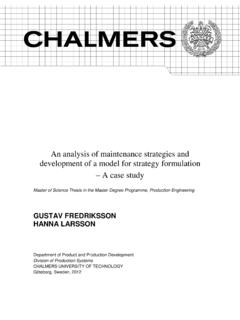Transcription of HUMAN PERFORMANCE IMPROVEMENT HANDBOOK …
1 DOE-HDBK-1028-2009 DOE STANDARD HUMAN PERFORMANCE IMPROVEMENT HANDBOOK VOLUME 1: CONCEPTS AND PRINCIPLES Department of Energy AREA HFAC Washington, 20585 DISTRIBUTION STATEMENT A. Approved for public release; distribution is unlimited. NOT MEASUREMENT SENSITIVE Available on the Department of Energy Technical Standards Program Web site at DOE-HDBK-1028-2009 i VOLUME 1: CONCEPTS AND PRINCIPLES PREFACE.
2 V Reading The vi CHAPTER 1 - INTRODUCTION TO HUMAN 1-1 Perspective on HUMAN PERFORMANCE and 1-10 HUMAN PERFORMANCE for Engineers and Knowledge Workers .. 1-11 The Work 1-11 Individuals, Leaders, and Organizations .. 1-12 HUMAN PERFORMANCE .. 1-12 1-13 ANATOMY OF AN EVENT ..1-14 Event ..1-14 Initiating 1-14 Flawed Controls .. 1-15 Error 1-15 Latent Organizational 1-15 STRATEGIC APPROACH FOR HUMAN PERFORMANCE .. 1-16 Reducing Error .. 1-16 Managing Controls .. 1-17 PRINCIPLES OF HUMAN PERFORMANCE .. 1-19 CHAPTER 2 - REDUCING ERROR ..2-1 HUMAN FALLIBILITY (Essential Reading) .. 2-1 Common Traps of HUMAN Nature.
3 2-1 Unsafe Attitudes and At-Risk Behaviors .. 2-4 Slips, Lapses, Mistakes, Errors and 2-8 Active 2-8 Latent Errors .. 2-9 Dependency and Team Errors .. 2-11 Equipment 2-11 DOE-HDBK-1028-2009 ii Team Errors .. 2-12 Personal Dependencies .. 2-15 PERFORMANCE MODES (Essential Reading) ..2-16 Information Processing, Memory, and 2-16 Generic Error Model System (GEMS) .. 2-20 Skill-Based 2-21 Examples of Skill-Based Activities .. 2-22 Skill-Based Error Mode 2-22 Rule-Based PERFORMANCE .. 2-23 Examples of Rule-Based 2-23 Rule-Based Error 2-24 Knowledge-Based 2-25 Examples of Knowledge-Based Activities.
4 2-26 Knowledge-Based Error Mode .. 2-26 How PERFORMANCE Modes Can be Used .. 2-27 Mental 2-29 Mental Biases 2-29 Conservative 2-30 ERROR-LIKELY SITUATIONS (Essential Reading).. 2-30 Error 2-31 Common Error 2-32 ERROR-PREVENTION 2-33 ATTACHMENT A ERROR 2-35 ATTACHMENT B COMMON ERROR-PRECURSOR DESCRIPTIONS .. 2-39 CHAPTER 3 - MANAGING CONTROLS ..3-1 3-1 Severity of Events .. 3-3 The Organization s Role in 3-3 Defense Functions .. 3-4 Reliability of 3-4 DEFENSE-IN-DEPTH .. 3-5 Engineered Controls .. 3-5 Administrative Controls .. 3-6 Cultural Controls Values, Beliefs, Attitudes.
5 3-8 DOE-HDBK-1028-2009 iii Work Group Norms .. 3-9 Leadership 3-10 Common Flaws with Cultural Controls .. 3-10 Oversight 3-10 Senior Management Team Focus on HUMAN PERFORMANCE .. 3-11 PERFORMANCE IMPROVEMENT Processes .. 3-11 HUMAN PERFORMANCE IMPROVEMENT Plans ..3-12 PERFORMANCE MODEL .. 3-12 Organizational 3-13 Organizational Factors .. 3-14 Job-Site Conditions .. 3-14 Worker 3-15 Plant Results .. 3-15 MANAGING CONTROLS PERFORMANCE IMPROVEMENT 3-15 METHODS (Tools) FOR FINDING LATENT ORGANIZATIONAL CONDITIONS .. 3-17 Self-Assessments .. 3-18 Behavior 3-18 Problem Reporting .. 3-19 Benchmarking.
6 3-19 PERFORMANCE Indicators and Trending .. 3-20 Operating Experience .. 3-20 Independent Oversight ..3-21 Problem Analysis .. 3-22 Management Oversight ..3-23 Surveys and 3-23 Corrective Action Program .. 3-23 Change 3-24 APPENDIX A: WARNING FLAGS FACTORS THAT DEFEAT CONTROLS .. 3-25 CHAPTER 4 - CULTURE AND LEADERSHIP ..4-1 ORGANIZATIONAL 4-1 SAFETY CULTURE ..4-2 How Organizations Process Information .. 4-5 LEADERSHIP .. 4-11 Leader s Role ..4-11 Production and Prevention: Competing 4-12 DOE-HDBK-1028-2009 iv KEY LEADERSHIP 4-13 Facilitate Open Communication .. 4-13 Promote Teamwork .. 4-13 Reinforce Expectations.
7 4-14 Eliminate Latent Organizational Weaknesses .. 4-16 Value the Prevention of Error .. 4-17 BEHAVIOR ENGINEERING MODEL (BEM) .. 4-17 CREATE A JUST 4-23 The Blame Cycle .. 4-23 Categories of Violations .. 4-23 The Foresight Test .. 4-24 The Substitution 4-25 The Culpability Decision Tree .. 4-25 ATTACHMENT A PERFORMANCE GAP ANALYSIS .. 4-27 ATTACHMENT B CULPABILITY DECISION TREE ..4-29 ATTACHMENT C ESTABLISHING A REPORTING 4-31 CHAPTER 5 - HUMAN PERFORMANCE EVOLUTION ..5-1 5-1 A Perspective on Organizations .. 5-1 FACTORS THAT IMPACT 5-2 5-2 Quality 5-3 HUMAN Factors and 5-4 Organizational Development.
8 5-6 Learning Organizations .. 5-8 HUMAN PERFORMANCE Error Management ..5-11 Mindfulness and 5-12 High Reliability Organizations .. 5-12 Resilience Engineering .. 5-16 Organizational 5-17 PERFORMANCE IMPROVEMENT In the Work 5-18 GLOSSARY .. i CONCLUDING xi DOE-HDBK-1028-2009 v PREFACE This HUMAN PERFORMANCE IMPROVEMENT HANDBOOK is a reference for anyone working in the Department of Energy (DOE) community who wants to learn more about HUMAN PERFORMANCE and how it can be improved. The HANDBOOK consists of five chapters entitled: An Introduction to HUMAN PERFORMANCE , Reducing Error, Managing Controls, Culture and Leadership , and Organizations at Work.
9 The HANDBOOK addresses the roles of individuals, leaders, and the organization in improving PERFORMANCE . Principles of HUMAN PERFORMANCE , outlined in Chapter 1, are the foundation blocks for the behaviors described and promoted in the HANDBOOK . The strategic approach for improving PERFORMANCE is to reduce HUMAN error and manage controls so as to reduce unwanted events and/or mitigate their impact should they occur. For the purposes of this HANDBOOK , an event is an undesirable change in the state of structures, systems, or components or HUMAN /organizational conditions (health, behavior, controls) that exceeds established significance criteria.
10 HUMAN PERFORMANCE IMPROVEMENT (HPI) as addressed in this HANDBOOK is not a program per se, such as Six Sigma, Total Quality Management, and the like. Rather, it is a set of concepts and principles associated with a PERFORMANCE model that illustrates the organizational context of HUMAN PERFORMANCE . The model contends that HUMAN PERFORMANCE is a system that comprises a network of elements that work together to produce repeatable outcomes. The system encompasses organizational factors, job-site conditions, individual behavior, and results. The system approach puts new perspective on HUMAN error: it is not a cause of failure, alone, but rather the effect or symptom of deeper trouble in the system.






